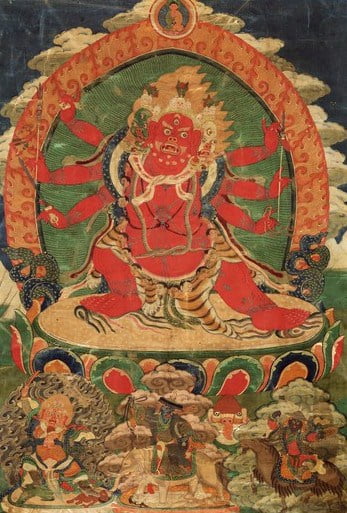Hayagriva is a wrathful manifestation of Avalokiteshvara. Avalokiteshvara embodies the compassion of all the buddhas and connects to the enlightened mind. In the Hayagriva manifestation, he represents the enlightened speech of all buddhas. He is the Heruka of the Lotus (Padma) Buddha Family. Referred to as “Lotus-like Speech”, he is usually depicted as red in color with a dark-green horse head with a blazing red mane emerging from his fiery red crown. The fierceness of his speech is represented by the screaming or neighing horse head. The neigh or cry of a wild horse on the Tibetan plains is known to have the loudest cry, but in this guise, it symbolizes the roar of Dharma carried by the wind.
Hayagriva can be depicted in a number of ways, often with three heads representing the three doors of body, speech, and mind. His six arms symbolize his overcoming of the suffering of the six realms through the practice of the six perfections (paramitas, Sanskrit pāramitās). Hayagriva can be shown with three faces: a smiling green face on the right, a white face on the left showing covetousness, and a red face in the center. Each face has three wrathful, bulging eyes, each seeing the three times of past, present, and future.
There are two stories associated with Hayagriva. In the first, Hayagriva is the wrathful form of Vajrasattva, who first appears as Avalokiteshvara. He then manifests as Hayagriva in order to defeat the powerful demon Maheśvara/Rudra, who has overpowered the gods. All peaceful means to suppress Rudra had failed, and thus the skillful means of wrath was necessary to overcome the destructive ego and attachment represented by Maheśvara/Rudra.
This story is told at length in chapters 5-8 of the Padma Thangyig Serteng or The Golden Rosary of the Lotus-born, written down by Khandro Yeshe Tsogyel.
Hayagriva joins forces with Vajrapani, who assumes the power of Tara and then becomes the wrathful Vajravārāhī. In their previous lives, Vajrasattva was Rudra’s master and Vajrapani was his fellow disciple, who unlike Rudra understood and respected the Buddhadharma. Hayagriva and Vajravārāhī engage with Rudra in a series of nine dances and fierce battles. Finally, Hayagriva shrinks in size and enters Rudra through his anus. Once inside, he then grows to gigantic proportion and destroys him from the inside out. Defeated, Rudra pledges to become a protector of dharma. Hayagriva then wears Rudra’s demonic body as a garment.
In another version of the tale, Vajrasattva impersonates Rudra and seduces his wife, the rakshasha queen Krodhisvari. Hayagriva is reborn as the resultant child, Vajrarakshasha, or Vajrakila, who takes over Rudra’s realm, subdues him, and destroys him by stabbing him in the chest with a three-pointed khaṭvāṅga. Vajrarakshasha then devours Rudra, purifying him in the process of digestion. When Rudra is excreted, he takes up the role of a dharma protector. His army of demons become his faithful attendants.


